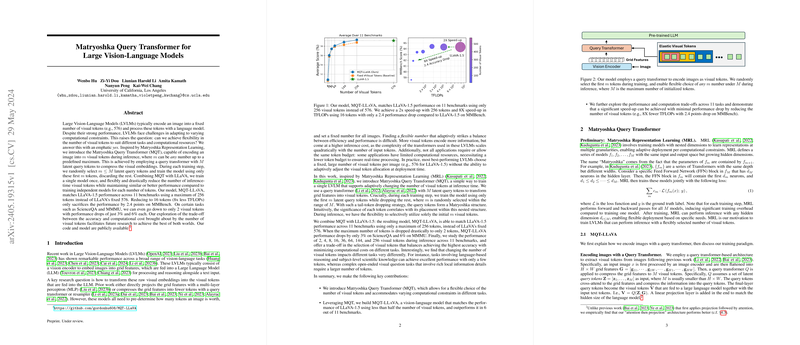Flexibly Adapting Visual Token Budgets: An Analysis of Matryoshka Query Transformers in Vision-LLMs
Overview
The paper introduces the concept of the Matryoshka Query Transformer (MQT) to address the challenge of fixed visual token budgets in Large Vision-LLMs (LVLMs). Traditional LVLMs are often constrained by a fixed number of visual tokens, resulting in inefficiencies when adapting to varying computational constraints across different applications. The proposed MQT model allows for a flexible and adaptive number of visual tokens, considerably enhancing computational efficiency while maintaining robust performance.
Matryoshka Query Transformer (MQT)
Inspiration and Concept
Inspired by Matryoshka Representation Learning, MQT employs a query transformer strategy designed to dynamically adjust the number of visual tokens during inference. During training, the model randomly selects a subset of latent query tokens within a predefined maximum, trimming the rest. This approach results in a Matryoshka-like nested structure, where each token's significance is correlated with its hierarchical placement within the structure.
Technical Implementation
The implementation integrates MQT with the Large Vision-LLM LLaVA, referred to as MQT-LLaVA. The training process is conducted in two stages: initial alignment and subsequent adaptive training with varying numbers of visual tokens. Using this methodology, MQT-LLaVA can effectively encode images into a dynamically chosen number of visual tokens (up to a maximum of 256), as opposed to the fixed 576 tokens in LLaVA-1.5.
Empirical Performance
Strong Numerical Results
MQT-LLaVA, with a maximum of 256 visual tokens, achieves performance on par with or better than LLaVA-1.5 across 11 benchmarks. Remarkably, reducing the token count to 16 (an 8x reduction in TFLOPs) only results in an approximate 2.4-point performance drop on MMBench. Specific tasks such as ScienceQA and MMMU show minimal performance degradation even with as few as 2 visual tokens.
Performance-Efficiency Trade-Offs
The paper finds that different tasks have varying dependencies on the number of visual tokens:
- High Token Requirement: Tasks such as VQAv2, GQA, and MMBench require more tokens for optimal performance due to their need for detailed visual understanding.
- Low Token Requirement: Other tasks, including ScienceQA and MME Cognition, maintain robust performance with significantly fewer tokens, suggesting that in these contexts, the LLM's reasoning capabilities overshadow the need for detailed visual tokens.
The flexible adaptation of visual token budgets enables significant computational savings without notable performance trade-offs, particularly for tasks demanding less fine-grained visual detail.
Implications and Future Research
Practical Impact
The proposed MQT-LLaVA model is highly versatile, making it applicable across diverse computational environments, from resource-constrained mobile devices to high-performance servers. The ability to dynamically adjust visual token budgets allows for real-time processing in applications with varying computational constraints.
Theoretical Contributions
The nested Matryoshka-like structure presents a novel means of organizing and efficiently utilizing visual tokens in LVLMs. This approach could influence future LVLM architectures, encouraging ongoing research into adaptive token strategies that further optimize computational efficiency and performance.
Speculative Future Directions
Looking forward, the principles established by MQT could be applied to other modalities beyond images, potentially influencing video and 3D data processing. Further exploration into the balance between the information density of visual tokens and computational cost stands to benefit the development of more scalable and resource-efficient models.
Conclusion
The Matryoshka Query Transformer model presents a substantive step towards addressing the rigidity of fixed visual token budgets in LVLMs. By enabling adaptive visual token counts during inference, the MQT model delivers substantial computational efficiency gains while preserving robust performance across varied vision-language tasks. This advancement underscores the potential for even more adaptable and efficient vision-LLMs in the future.
